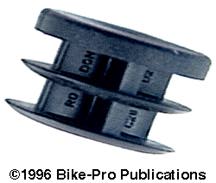
There are a few things you should know about handlebar extensions, bend style, fastening styles, and construction techniques.
The majority of bar ends are made using a process called TIG (Tungsten Inert Gas) welding, this allows the builder to join two pieces of metal with exactly the same alloy, of the same metal, making an incredibly strong joint. The alternate method of fastening the pieces of bar ends together is called bonding. This uses an epoxy adhesive to join the parts together.
There are two ways handle bar ends are fastened to the handlebar. The most common is the cinch style. This involves the use of a cast aluminum clamp, or a small piece of tubing around the handle bar that has fittings, like a stem, to draw the bar end cinch piece tight to the handlebar. Cinch styles require, and use, a steel bolt to tighten them. The other, less used, style of fastening is "wedge style", this is the way stems fasten into fork steerer tubes. There is a cut wedge of metal that is threaded, which slides against another incline plane cut on the bar end itself. As the two slide against each other, it produces a greater circumference, and expands against the inner diameter of the handlebar. Occasionally there are handlebars that have a broader inner diameter than the wedge system can accommodate directly. In these cases you get the next larger size of the bar end that will fit your bar, or in some cases an aluminum tube cut lengthwise is provided to slide over the wedge assembly to act as a shim. The shim system is quite satisfactory, and produces a rigid grip on the inner handlebar.
Many, but not all, of the bar ends we sell, come with tubing end plugs, so dirt won't get into the handlebar or the bar end. It also keeps you from serious injury through an accidental Biopsic procedure. When the bar ends come with end plugs, we say so. In a few cases, rubber hoods, or boots, come with the bar ends to cover the entire cinch area, which also closes off the end of the handlebar.
Handlebar extensions come in three styles of bend, Straight, Ski, or "L" bend. The straight bar end has the grip tube as a straight piece welded at an angle onto the fastening assembly. This was the first style made. As things became more sophisticated the Ski and L bend followed. The "L" bend has the grip tubing bent in the middle and welded, at a slight angle, to the fastening assembly, generally flat with no upward bend at the tip of the handlebar extension and offer 2 hand positions. The "Ski" bend has the grip section placed at a slight angle to the fastening assembly with an upward bend, at it's end like a ski tip, so there is a vertical grip surface.

Many of the American made bar ends use the same press-in grip tube/handlebar end plug. Molded with re-inforcements, it's made of Black plastic, this is the Rodon end plug being sourced through Out Water Plastic in Woodridge, New Jersey. This plug is well suited for this application, because of its strength, while being very lightweight. Each of these Rodon plugs weighs 2.63 grams.
All bar ends have been weighed from production models, to 1/4 gram resolution, no matter what a maker says, these are the real weights. The choice of whether to image (photograph) a right or left hand version of the bar end, because I am a leftist, was purely political.
